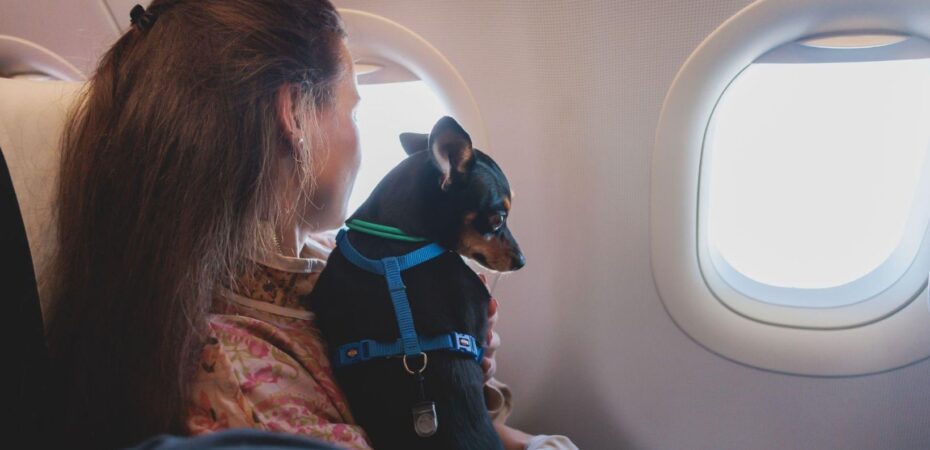Your psychiatric service dog is an important companion, and you should have to lose access to your service dog if you need to take a flight somewhere. Fortunately, there are laws in place that ensure you can bring your psychiatric service dog with you as you fly to, within, and from the United States, so you won’t need to be separated from your essential working pup.
Our article gives you more information on psychiatric service dogs and the Air Carrier Access Act, in addition to what you can expect when flying with a psychiatric service dog.
Psychiatric Service Dogs and the Air Carrier Access Act
Taking your psychiatric service dog (PSD) onboard an airplane with you might seem confusing and difficult at first, but you should know that your right to travel with your PSD is covered by the Air Carrier Access Act.
This act was passed in 1986 and ensures that service dogs, defined in the Air Carrier Access Act as “dog, regardless of breed or type, that is individually trained to do work or perform tasks for the benefit of a qualified individual with a disability, including a physical, sensory, psychiatric, intellectual, or other mental disability,” are able to accompany their owners onboard an aircraft.
Airlines must provide accommodations for individuals traveling with their PSD, but you may need to complete several steps, such as paperwork and travel forms, before you are allowed to take your service dog onto the aircraft with you.
It’s important to note that emotional support animals and therapy animals that are not trained to counteract a specific part of an individual’s disability are not considered service animals and are not required to be accepted by airlines.
Prepare Your Psychiatric Service Dog for Travel
Preparing your psychiatric service dog for travel involves a few different steps.
First, you will need to check with the airline you are flying with directly to find out their rules on registering your PSD for travel and which documents you might be required to present at the airport.

Most airlines will require you to submit the U.S. Department of Transportation Service Animal Air Transportation Form several days before departure, and some airlines may also require the U.S. Department of Transportation Service Animal Relief Attestation Form.
The airline you are traveling with will instruct you on how to submit these forms and secure a place for your PSD on the aircraft.
You will also need to make sure your PSD is prepared for airline travel by giving your pup a meal 4 to 6 hours before the flight, as eating right before the flight may make them nauseous, and finding an animal relief area for them to relieve themselves right before the flight.
You will also need to make sure you have adequate water, food, and treats with you, and you may need to bring calming items for your dog if you anticipate them becoming nervous during travel.
Do I Need to Identify My Psychiatric Service Dog?
While it isn’t required to purchase a vest, marked leash, or other identifying items for your PSD, many individuals do this to make traveling with their service dog through their airport easier.
When you mark that your pup is an essential working companion, you will find that more people act appropriately around your dog (such as not trying to pet them and avoiding contact), and you will need to answer fewer questions. However, it is not legally required to use these items, so only do so if you feel comfortable with a vest or marked leash for your PSD.
What to Expect at the Airport
Once you arrive at the airport with your psychiatric service dog, you will need to progress through security and check-in.
Airline staff may ask for more information about your PSD, and you may be able to hand in any additional required forms before boarding your plan. Make sure when checking in with the airline that you ensure there is a space for your PSD and that all documents are received, as this prevents your trip from encountering issues.
When it is time to board the plane, you may be able to keep your PSD in a carrier under the seat in front of you, on your lap, or at your feet, as long as your dog does not end up in the aisle at all.
Most of the time, you will need to obtain a bulkhead seat or a seat with extra legroom to accommodate your dog; this shouldn’t have an extra cost as it is a required disability accommodation.
What Can Airlines Ask Me About My Psychiatric Service Dog?
Airline staff will likely ask you for additional information about your psychiatric service dog during the security and check-in process. It’s important to note that airline staff are only allowed to ask you two questions:

- Is the dog a service animal required because of a disability?
- What work or task has the dog been trained to perform?
You are only legally obligated to give answers to these two questions, and you do not have to go into detail. You are not required to show proof of training, demonstrate your dog’s skills, or supply the airline with any type of certification or prescriptions for your psychiatric service dog, as this violates the Air Carrier Access Act and the Americans With Disabilities Act.
Can an Airline Refuse My Psychiatric Service Dog?
An airline may be able to legally refuse your psychiatric service dog, depending on the circumstances and your dog’s behavior. In general, refusals to board PSDs or other service dogs occur when:
- Your PSD violates safety requirements, such as being too large or heavy to be properly accommodated in the aircraft cabin.
- Your PSD poses a direct threat to the health or safety of others, such as being aggressive, biting, barking, or not properly bathroom trained.
- Your PSD is causing significant disruption in the cabin or around the airport’s gate areas.
- Your PSD is prohibited from entering a certain U.S. territory or foreign country due to health requirements or other restrictions.
- Your PSD does not have the completed Department of Transportation animal forms, and you did not complete and submit these documents to the airline when asked before boarding.
Keep in mind that reasons for denying a psychiatric service dog boarding on an aircraft other than these may be discriminatory, and you should consult the airline and legal assistance if you believe you have been wrongly denied boarding a flight with your PSD.
Keeping Your Service Animal by Your Side
For many individuals with disabilities, it’s essential to keep their service dog by their side, no matter what. If you find yourself needing to fly within the United States or to a foreign country with your psychiatric service dog, you may be nervous about bringing your pup with you.
However, you don’t need to worry, as there are several laws in place that protect your right to bring your psychiatric service dog with you no matter what.
Consult specific rules for registering your PSD with the airline you are traveling with and make sure to submit all pre-flight paperwork in addition to ensuring your dog is well-trained to make your flight experience with your psychiatric service dog a stress-free one.


 By
By 



